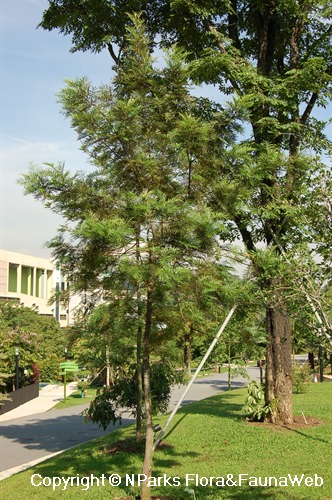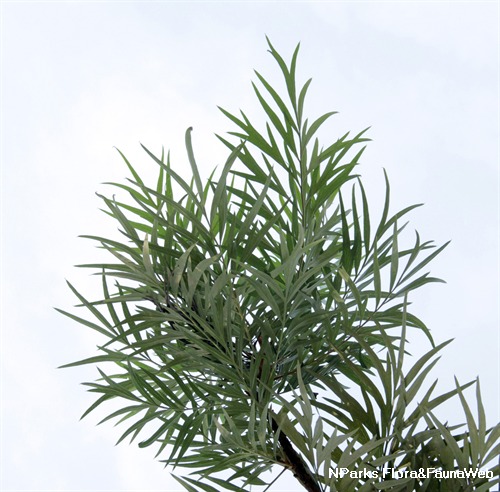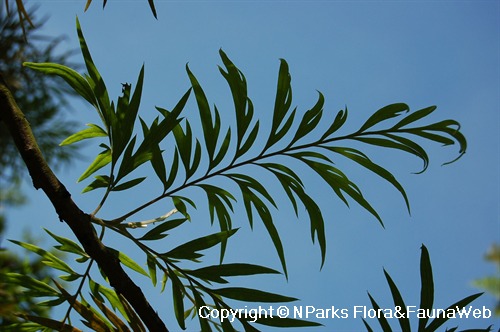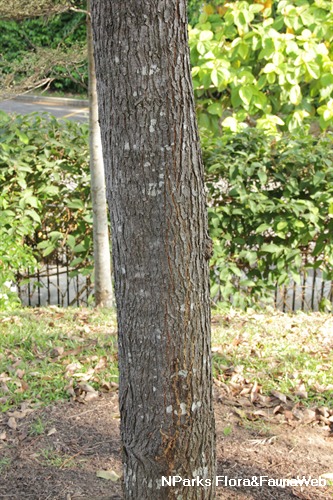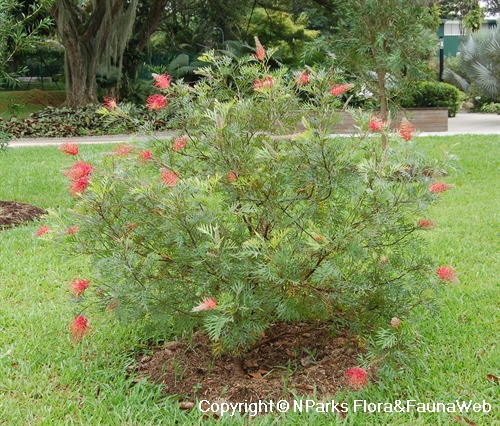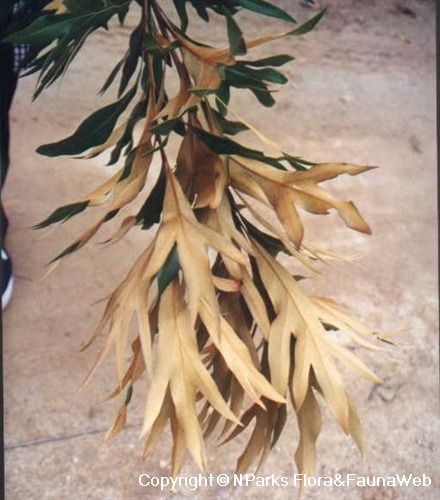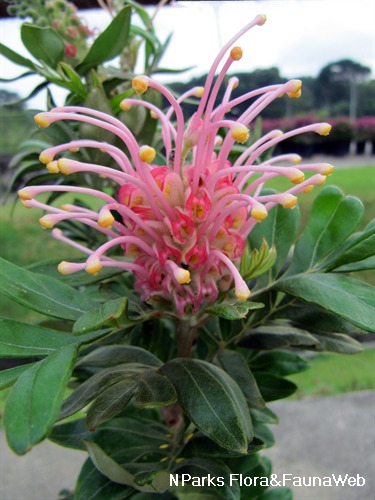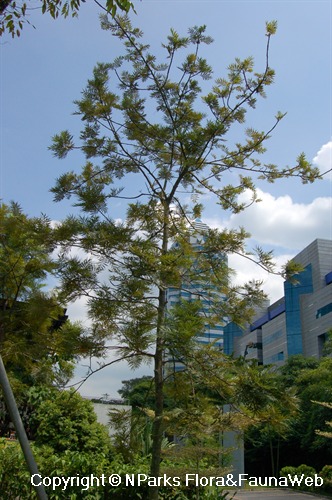
Back
Grevillea robusta A.Cunn. ex R.Br.
| Family Name: | Proteaceae |
| Synonyms: | Grevillea robusta var. compacta, Stylurus robusta, Grevillea umbratica |
| Common Name: | Silky Oak, Australian Silky Oak, Southern Silky Oak, Silk Oak, Silkoak |
Name
Classifications and Characteristics
| Plant Division | Angiosperms (Flowering Seed Plants) (Dicotyledon) |
|---|---|
| Plant Growth Form | Tree (Big (>30m)) |
| Lifespan (in Singapore) | Perennial |
| Mode of Nutrition | Autotrophic |
| Plant Shape | Oval |
| Maximum Height | 10 m to 40 m |
| Maximum Plant Spread / Crown Width | 5 m to 20 m |
| Tree or Palm – Trunk Diameter | 0 |
Biogeography
| Native Distribution | Australia |
|---|---|
| Native Habitat | Terrestrial (Riverine) |
| Preferred Climate Zone | Sub-Tropical / Monsoonal |
Description and Ethnobotany
| Growth Form | Tall, evergreen tree with an oval or pyramidal crown. It sometimes becomes semi-deciduous during droughts or cold winters. |
|---|---|
| Trunk | Grey or dark brown bark is deeply fissured and furrowed. Young stem is tomentose and orangish-brown near the tip, but whitish further from the tip. |
| Foliage | Leaves are compound with each leaflet dissected into 11 - 21 small lobes. Young foliage is silvery and tomentose. |
| Flowers | Flowers are usually orange-yellow, but occasionally red or having red patches. They are arranged in horizontal spike inflorescences (12 cm long). Flowers are pollinated by birds, bats and flying foxes which feed on their nectar. |
| Fruit | Fruits are egg-shaped or ellipsoid follicles that are slightly flattened (0.9 - 1.1 cm wide, 1.3 - 1.6 cm long). Each fruit has a thin, curved beak-like projection. Seeds are flat and oval, having a membranous wing that completely surrounds it. |
| Habitat | Occurs in 3 types of habitats: 1) rainforest margins and along riverbanks and streambanks in rainforests, 2) riverine sclerophyll communities dominated by Allocasuarina cunninghamiana and 3) hill slopes in vine thickets and forests dominated by Araucaria spp. It occurs in locations where annual rainfall is 600 - 1700 mm. |
| Cultivation | This species is fast-growing, requiring little maintenance. It should be planted in well-drained soil with high organic matter content. Feed with fertilizers that are rich in nitrogen and have less phosphorous. Trees may be shaped with moderate amounts of pruning. Indoor plants should be placed in a sunny location, watered thoroughly and fertilised regularly. It is susceptible to root rot caused by the fungus Armillaria mellea. This species is easy to propagate by seed, stem cuttings or grafting. Freshly harvested seeds are easy to germinate. Soak the seeds in water for one day to make them germinate faster. Stem cuttings from young branches typically root without any problems. |
| Etymology | The genus name "Grevillea" is named after Charles Francis Greville (1749 - 1809) who helped to establish a society now called the Royal Horticultural Society. The species epithet "robusta" means large or strong in Latin and it refers to this species' large growth form. The common name "Silky Oak" is a reference to the wood which is similar to oak, but has a silk-like texture after being split. |
| Ethnobotanical Uses | Edible Plant Parts : Edible Flowers Medicinal: In China, the leaves are used to heal minor cuts. Timber & Products: The pale yellowish or yellow-brown wood is easy to shape and is used to make various objects (eg., furniture) or construct buildings. Timber use of this species is most common in Malaysia and Africa. It is also used as firewood. In Africa, coffee is grown in the shade of this species in some plantations. Agriculture - Forestry: In Hawaii, many individuals of this species have been planted in forest reserves. Others: The Aborigines in Australia used the flowers to make sweet beverages. |
Landscaping Features
| Landscaping | This tree is prized for its abundant flowering which can cover the tree canopy. It is an ideal amenity tree for parks, providing abundant shade while occasionally adding dramatic bursts of colour to the landscape. Individuals of this species should not be planted near each other, because their roots produce toxic allelochemicals that inhibit same species growth. This species could be planted in the background of a mixed boundary planting or border. Although this species is often used as a roadside tree or planted in home gardens, it is usually not suitable for these purposes. The tree eventually attains a massive size and has considerable surface roots that will destroy nearby pavement. This species is best grown outdoors, but it can also be grown indoors. |
|---|---|
| Desirable Plant Features | Ornamental Flowers, Ornamental Foliage |
| Landscape Uses | General, Shade Providing Tree / Palm |
Fauna, Pollination and Dispersal
| Fauna Pollination Dispersal Associated Fauna | Bird-Attracting |
|---|---|
| Pollination Method(s) | Biotic (Fauna) (Vertebrates (Bird), Vertebrates (Bat), Vertebrates (Other Mammal)) |
| Seed or Spore Dispersal | Biotic (Fauna) |
Plant Care and Propagation
| Light Preference | Full Sun |
|---|---|
| Water Preference | Moderate Water |
| Plant Growth Rate | Fast, Moderate |
| Rootzone Tolerance | Drought Tolerant, Fertile Loamy Soils, Well-Drained Soils |
| Maintenance Requirements | Low |
| Diseases | Armillaria mellea (fungus) attacks roots. |
| Propagation Method | Seed, Stem Cutting, Grafting |
Foliar
| Foliage Retention | Evergreen |
|---|---|
| Mature Foliage Colour(s) | Green |
| Mature Foliage Texture(s) | Smooth |
| Foliar Type | Compound (Odd-Pinnate) |
| Foliar Arrangement Along Stem | Alternate |
| Foliar Shape(s) | Non-Palm Foliage (Lanceolate) |
| Foliar Venation | Pinnate / Net |
| Foliar Margin | Pinnately Lobed / Pinnatifid |
| Foliar Apex - Tip | Acute |
| Foliar Base | Rounded / Obtuse |
Non - Foliar and Storage
| Trunk Type (Non Palm) | Woody |
|---|---|
| Bark Colour(s) | Grey, Dark brown |
| Mature Bark Texture | Fissured |
| Root Type | Underground (Tap Root) |
Floral (Angiosperm)
| Flower Colour(s) | Orange, Yellow / Golden |
|---|---|
| Flower Size - Remarks | 2 cm long |
| Inflorescence Type | Spike |
| Flowering Period | Free-Flowering |
| Flowering Habit | Polycarpic |
Fruit, Seed and Spore
| Mature Fruit Colour(s) | Black, Brown |
|---|---|
| Fruit Classification | Simple Fruit |
| Fruit Type | Dehiscent Dry Fruit , Follicle |
Image Repository
Others
| Master ID | 1651 |
|---|---|
| Species ID | 2944 |
| Flora Disclaimer | The information in this website has been compiled from reliable sources, such as reference works on medicinal plants. It is not a substitute for medical advice or treatment and NParks does not purport to provide any medical advice. Readers should always consult his/her physician before using or consuming a plant for medicinal purposes. |

